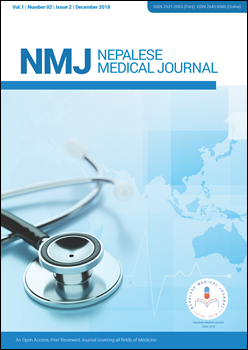Endovenous Ablation of Varicose Veins Experience at Tertiary Neurological Center
DOI:
https://doi.org/10.3126/nmj.v1i2.21580Keywords:
Ablation, Endovascular, Thermal, VaricoseAbstract
Introduction: Endovascular ablation of varicose vein either by radiofrequency ablationor laser delivers sufficient thermal energy to incompetent vein segments to produce irreversible occlusion, fibrosis and ultimately disappearance of the vein.
Materials and Methods: Three hundred patients with varicosities due to primary or recurrent sapheno-femoral or sapheno-popliteal junction and great or small saphenous veinreflux underwent out-patient and in-patient endovenous thermal ablation between January 2015 to December 2017.The great saphenous vein was ablated from 2-2.5 cm below sapheno-femoral junction to knee and the small saphenous vein was ablated from mid-calf to the sapheno-popliteal junction.
Results: Patient returning time to normal activity was 0–1 days returning to normal daily activity were immediately after 4 hours. Duplex ultrasound follow-up (median 3-months) confirmed abolition of sapheno-femoral junction/great saphenous vein and sapheno-popliteal junction/small saphenous vein reflux in all limbs. There were no instances of skin burns or deep vein thrombosis, but, 7 patients developed transient cutaneous numbness involving sural nerve and 1 developed endovenous heat induced thrombosis 3.
Conclusions: This is likely to be more effective than conventional surgery, although long-term follow up is required. Despite being expensive in comparison to open surgery, endovenous thermal ablation is superior in terms of: minimizing pain, avoiding incision, early mobilisation and discharge. Changing the treatment distance from 2 cm to 2.5 cm peripheral to the Deep veins junction may result in a diminished incidence of endovenous heat induced thrombosis 3.
Downloads
Downloads
Published
How to Cite
Issue
Section
License
This license enables reusers to distribute, remix, adapt, and build upon the material in any medium or format, so long as attribution is given to the creator. The license allows for commercial use.
Copyright on any article published by Nepalese Medical Journal is retained by the author(s).
Authors grant Nepalese Medical Journal a license to publish the article and identify itself as the original publisher.
Authors also grant any third party the right to use the article freely as long as its integrity is maintained and its original authors, citation details and publisher are identified.




